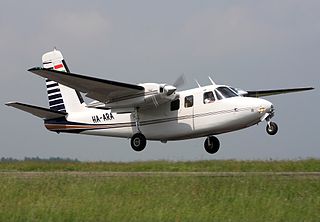
An aerospace manufacturer is a company or individual involved in the various aspects of designing, building, testing, selling, and maintaining aircraft, aircraft parts, missiles, rockets, or spacecraft. Aerospace is a high technology industry.

Aerospace is a term used to collectively refer to the atmosphere and outer space. Aerospace activity is very diverse, with a multitude of commercial, industrial, and military applications. Aerospace engineering consists of aeronautics and astronautics. Aerospace organizations research, design, manufacture, operate, or maintain both aircraft and spacecraft.

The Bell Aircraft Corporation was an American aircraft manufacturer, a builder of several types of fighter aircraft for World War II but most famous for the Bell X-1, the first supersonic aircraft, and for the development and production of many important civilian and military helicopters. Bell also developed the Reaction Control System for the Mercury Spacecraft, North American X-15, and Bell Rocket Belt. The company was purchased in 1960 by Textron, and lives on as Bell Textron.

Curtiss Aeroplane and Motor Company was an American aircraft manufacturer originally founded by Glenn Hammond Curtiss and Augustus Moore Herring in Hammondsport, New York. After significant commercial success in its first decades, it merged with the Wright Aeronautical to form Curtiss-Wright Corporation.

Wright Aeronautical (1919–1929) was an American aircraft manufacturer headquartered in Paterson, New Jersey. It was the successor corporation to Wright-Martin. It built aircraft and was a supplier of aircraft engines to other builders in the golden age of aviation. Wright engines were used by Amelia Earhart and Charles Lindbergh. In 1929, the company merged with Curtiss Aeroplane and Motor Corporation to form Curtiss-Wright.

The Goodrich Corporation, formerly the B.F. Goodrich Company, was an American manufacturing company based in Charlotte, North Carolina. Founded in Akron, Ohio in 1870 as Goodrich, Tew & Co. by Dr. Benjamin Franklin Goodrich, the company name was changed to the "B.F. Goodrich Company" in 1880, to BFGoodrich in the 1980s, and to "Goodrich Corporation" in 2001. Originally a rubber manufacturing company known for automobile tires, the company diversified its manufacturing businesses throughout the twentieth century and sold off its tire business in 1986 to focus on its other businesses, such as aerospace and chemical manufacturing. The BFGoodrich brand name continues to be used by Michelin, who acquired the tire manufacturing business in 1988. Following the acquisition by United Technologies in 2012, Goodrich became a part of UTC Aerospace Systems.

General Electric Company, doing business as GE Aerospace, is an American aircraft engine supplier that is headquartered in Evendale, Ohio, outside Cincinnati. It is the legal successor to the original General Electric Company founded in 1892, which split into three separate companies between November 2021 and April 2024, adopting the trade name GE Aerospace after divesting its healthcare and energy divisions.

Aero Commander was an aircraft manufacturer formed in 1944. In subsequent years, it became a subsidiary of Rockwell International and Gulfstream Aerospace. The company ceased aircraft production in 1986.
Nash-Kelvinator Corporation was the result of a merger in 1937 between Nash Motors and Kelvinator Appliance Company. The union of these two companies was brought about as a result of a condition made by George W. Mason prior to his appointment as CEO of Nash. The company manufactured cars and refrigerators as well as aeronautic components and helicopters during World War II. In 1954, the company merged with Hudson Motors to form American Motors Corporation (AMC).

Hamilton Standard was an American aircraft propeller parts supplier. It was formed in 1929 when United Aircraft and Transport Corporation consolidated Hamilton Aero Manufacturing and Standard Steel Propeller into the Hamilton Standard Propeller Corporation. Other members of United Aircraft included Boeing, United Airlines, Sikorsky and Pratt & Whitney. At the time, Hamilton was the largest manufacturer of aircraft propellers in the world.

Safran S.A. is a French multinational aerospace and defense corporation that designs, develops and manufactures aircraft engines, helicopter engines, spacecraft propulsion systems as well as various other aerospace and military equipment. The company arose in 2005 through a merger between SNECMA and defense electronics specialist SAGEM. Safran's acquisition of Zodiac Aerospace in 2018 significantly expanded its aeronautical activities.
Moog is an American-based designer and manufacturer of electric, electro-hydraulic and hydraulic motion, controls and systems for applications in aerospace, defense, industrial and medical devices. The company operates under four segments: aircraft controls, space and defense controls, industrial controls, and components. Moog is headquartered in Elma, New York and has sales, engineering, and manufacturing facilities in twenty-six countries.
Calspan Corporation is a science and technology company founded in 1943 as part of the Research Laboratory of the Curtiss-Wright Airplane Division at Buffalo, New York. Calspan consists of four primary operating units: Flight Research, Transportation Research, Aerospace Sciences Transonic Wind Tunnel, and Crash Investigations. The company's main facility is in Cheektowaga, New York, while it has other facilities such as the Flight Research Center in Niagara Falls, New York, and remote flight test operations at Edwards Air Force Base, California, and Patuxent River, Maryland. Calspan also has thirteen field offices throughout the Eastern United States which perform accident investigations on behalf of the United States Department of Transportation. Calspan was acquired by TransDigm Group in 2023.
Collins Aerospace is an American technology company that is one of the world's largest suppliers of aerospace and defense products. Headquartered in Charlotte, North Carolina, it is a subsidiary of RTX Corporation.
Lear Siegler Incorporated (LSI) is a diverse American corporation established in 1962. Its products range from car seats and brakes to weapons control systems for military fighter planes. The company's more than $2 billion-a-year annual sales comes from three major areas: aerospace-technology, automotive parts, and industrial-commercial. The company, however, is basically anonymous, since its products are either unmarked or bear only the label "LSI". Lear Siegler went private in 1987.

Daher is a French industrial conglomerate. It is operational across the aerospace, defence, nuclear, and automotive industrial sectors in the fields of manufacturing, services, and transport.
TransDigm Group Incorporated is an American publicly traded aerospace manufacturing company headquartered in Cleveland, Ohio. TransDigm develops and manufactures engineered aerospace components. It was founded in 1993, when four industrial aerospace companies were combined by a private equity firm in a leveraged buyout. TransDigm expanded the range of aerospace components it manufactures through acquisitions over the years. It filed an initial public offering on the New York Stock Exchange in 2006.

The Menasco Motors Company was an American aircraft engine and component manufacturer.
UTC Aerospace Systems (UTAS) was one of the world’s largest suppliers of aerospace and defense products, headquartered in Charlotte, North Carolina, United States. The company was formed in August 2012 when parent United Technologies Corporation merged their existing subsidiary Hamilton Sundstrand with the newly-acquired Goodrich Corporation. In 2018, UTC acquired Rockwell Collins which was merged to form Collins Aerospace.

RTX Corporation, formerly Raytheon Technologies Corporation, is an American multinational aerospace and defense conglomerate headquartered in Arlington, Virginia. It is one of the largest aerospace and defense manufacturers in the world by revenue and market capitalization, as well as one of the largest providers of intelligence services. In 2023, the company's seat in Forbes Global 2000 was 79. RTX manufactures aircraft engines, avionics, aerostructures, cybersecurity solutions, guided missiles, air defense systems, satellites, and drones. The company is also a large military contractor, getting a significant portion of its revenue from the U.S. government.
















